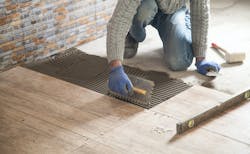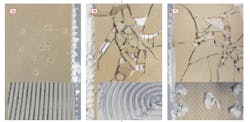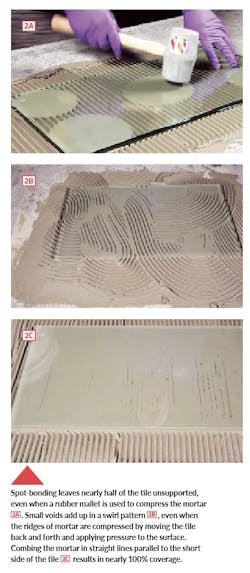How to Lay Big Tile
By now we can all agree that the condition of the substrate is a critical factor in the durability of a tile installation. Deflection, delamination, and expansion and contraction in structural members and subflooring can cause cracking in even the most durable tile and stone flooring materials. But even when these deficiencies are absent, improper installation can still lead to cracking and breakage. One surprising culprit is improper troweling technique, as explained in a video at ProTradeCraft.com produced by the National Tile Contractor’s Association (NTCA) called “Trowel and Error.”
Troweling techniques for installing large-format tiles
The only difference between these three porcelain tiles is the way the mortar was troweled onto the substrate. The tile set in a combed pattern shows only cosmetic damage (1A).The tile set using a technique called “spot-bonding”―a series of regularly spaced dollops of mortar ―easily shatters when struck with a hammer (1C), as does the tile set in a swirl pattern (1B).
Troweling technique is always important in achieving proper adhesion, but it is particularly critical with large-format tiles. (A “large-format” tile is defined as 16 x 16 inches or larger. Tile planks are also considered to be large-format if one edge is greater than 15 inches.) Even porcelain tiles, which can typically withstand heavy impacts and point loads, are susceptible to breakage if they are not properly supported by the mortar. This is dramatically demonstrated in the video when three identical tiles are set in mortar that has been applied using three different troweling techniques. After the mortar has set, each tile is struck a half-dozen times with a steel hammer . Two of the tiles shatter at each impact, but the third shows only cosmetic damage to the surface.
Swirling may beVoids and Air Pockets
The reason is that both swirling and spot-bonding leave voids and air pockets under the tile that make it vulnerable to breakage from heavy loads and impacts. This problem is clearly visible when each troweling method is demonstrated using large-format, clear glass tiles . In the case of spot-bonding, almost half of the tile is completely unsupported. Lack of support is less obvious with swirled mortar, but the large number of air pockets trapped under the tile add up to an unsupported area that also fails to meet industry standards established by ANSI (American National Standards Institute) and TCNA (Tile Council of North America), which require 80% coverage for interior applications, and 95% coverage for exteriors, wet environments, and all natural stone. By contrast, combing the mortar in straight lines parallel to the short side of the tile results in nearly 100% coverage.
The straight-line combing technique works so well for two reasons: 1. The ridges left in the mortar by the trowel collapse more easily when they all run in the same direction; and 2. air is able to escape more easily at the edges of the tile as the mortar is compressed. Together, these factors result in better support for the tile and a stronger bond between the tile and the substrate.
Installation Checklist
While the NTCA video is focused on correct troweling technique for large-format tiles, it also provides a concise checklist for overall installation, which is listed below. But prior to working with mortar, checking both the tile and the substrate for flatness is an important first step. Many large tiles tend to warp during manufacturing, so that the corners are out of plane with the center of the tile. Laying tile in a grid patterns can make it easier to keep edges flush, but a thicker layer of mortar may be required to achieve adequate mortar coverage. That said, even a perfectly flat large-format tile with be vulnerable if the substrate isn’t flatter than normal. As noted in the video, ANSI and TCNA specify that variations should not exceed ¼ inch in 10 feet. Even less variation is permissible for tile with any side that is 15 inches or longer: ⅛-inch variation in 10 feet, with no more than 1⁄16-inch variation in 24 inches. A detailed discussion of substrate preparation is a topic for another time, but most defects can be remedied with a patching or leveling compound, and as a last resort, grinding.
• Apply a thin coat of mortar to the substrate with the flat edge of the trowel. This helps achieve a strong mechanical bond.
• Add more mortar and comb it in straight lines parallel to the short side of the tile.
• Use a trowel large enough to achieve a continuous 3⁄32-inch-thick layer of mortar under the tile after setting. (Editor’s note: Although we could not find a specific standard for trowel notch size, most sources we consulted agreed that larger tiles typically require larger notches. However, when using large, thin tiles or large, heavy tiles, best practice is to check with the manufacturer for recommendations about both mortar and trowel size.)
• Back-butter the tile. Use the flat side of the trowel to get an even coat of mortar and fill all the spaces in the surface.
• Set the tile firmly in the mortar and move it back and forth up to ½ inch. Move the tile only in the direction perpendicular to the ridges, and avoid twisting the tile.
• When you first start setting, remove a tile to check for coverage. Ridges should be collapsed and there should be no missing mortar on the substrate or the back of the tile. Check mortar coverage periodically throughout the installation.
This article is adapted from a page at ProTradeCraft.com that features a video called “Trowel and Error” produced by the National Tile Contractor’s Association (NTCA), a nonprofit trade association supporting professional installation of tile and stone through education, training, and support for the development of industry standards and methods.



